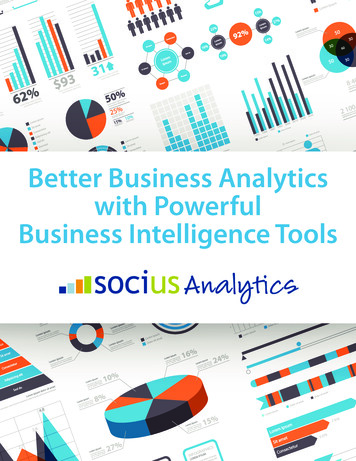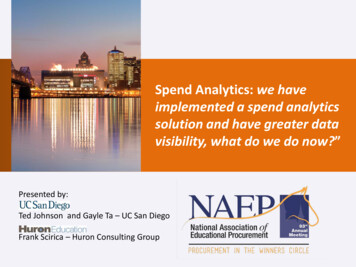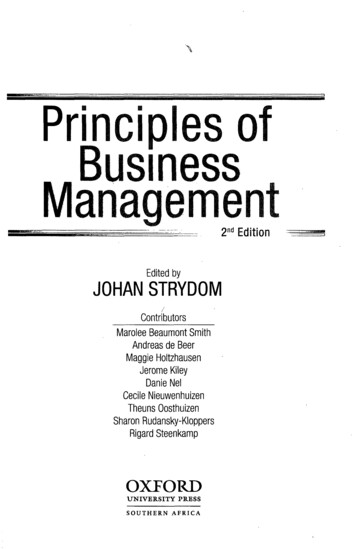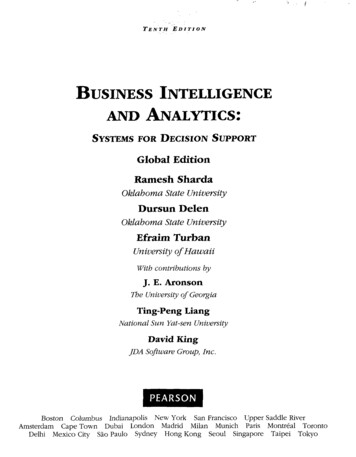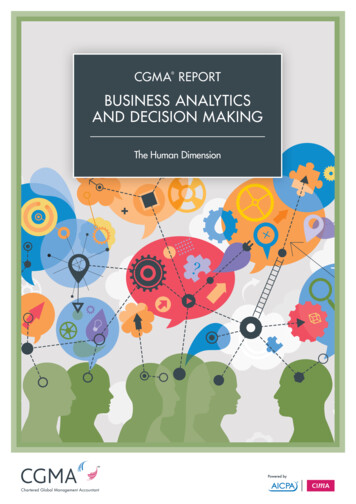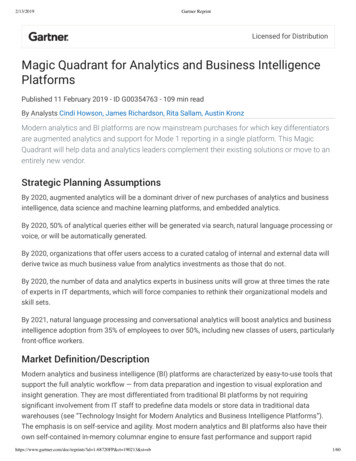
Transcription
Business AnalyticsPrinciples, Concepts, andApplications
This page intentionally left blank
Business AnalyticsPrinciples, Concepts, andApplicationsWhat, Why, and HowMarc J. SchniederjansDara G. SchniederjansChristopher M. StarkeyPearson
Associate Publisher: Amy NeidlingerExecutive Editor: Jeanne Glasser LevineOperations Specialist: Jodi KemperCover Designer: Alan ClementsCover Image: Alan McHughManaging Editor: Kristy HartSenior Project Editor: Lori LyonsCopy Editor: Gill Editorial ServicesProofreader: Katie MatejkaIndexer: Erika MillenSenior Compositor: Gloria SchurickManufacturing Buyer: Dan Uhrig 2014 by Marc J. Schniederjans, Dara G. Schniederjans, and Christopher M. StarkeyPearson Education, Inc.Upper Saddle River, New Jersey 07458For information about buying this title in bulk quantities, or for special sales opportunities (which may includeelectronic versions; custom cover designs; and content particular to your business, training goals, marketing focus, orbranding interests), please contact our corporate sales department at corpsales@pearsoned.com or (800) 382-3419.For government sales inquiries, please contact governmentsales@pearsoned.com.For questions about sales outside the U.S., please contact international@pearsoned.com.Company and product names mentioned herein are the trademarks or registered trademarks of their respectiveowners.All rights reserved. No part of this book may be reproduced, in any form or by any means, without permission inwriting from the publisher.Printed in the United States of AmericaFirst Printing: April 2014ISBN-10: 0-13-355218-7ISBN-13: 978-0-13-355218-8Pearson Education LTD.Pearson Education Australia PTY, Limited.Pearson Education Singapore, Pte. Ltd.Pearson Education Asia, Ltd.Pearson Education Canada, Ltd.Pearson Educación de Mexico, S.A. de C.V.Pearson Education—JapanPearson Education Malaysia, Pte. Ltd.Library of Congress Control Number: 2014931049
This book is dedicated to Miles Starkey.He is what brings purpose to our livesand gives us a future.
This page intentionally left blank
Contents-at-a-GlancePreface . . . . . . . . . . . . . . . . . . . . . . . . . . . . . . . . . . . . . . . . . xviPART I:What Are Business Analytics . . . . . . . . . . . . . . . . . . . . . . 1Chapter 1:What Are Business Analytics? . . . . . . . . . . . . . . . . . . . . . . . . . 3PART II:Why Are Business Analytics Important . . . . . . . . . . . . . 15Chapter 2:Why Are Business Analytics Important? . . . . . . . . . . . . . . .17Chapter 3:What Resource Considerations Are Importantto Support Business Analytics? . . . . . . . . . . . . . . . . . . . . . . .29PART III:How Can Business Analytics Be Applied . . . . . . . . . . . 43Chapter 4:How Do We Align Resources to SupportBusiness Analytics within an Organization? . . . . . . . . . . . . .45Chapter 5:What Are Descriptive Analytics? . . . . . . . . . . . . . . . . . . . . .63Chapter 6:What Are Predictive Analytics?. . . . . . . . . . . . . . . . . . . . . . .93Chapter 7:What Are Prescriptive Analytics? . . . . . . . . . . . . . . . . . . . .119Chapter 8:A Final Case Study Illustration . . . . . . . . . . . . . . . . . . . . . .139PART IV:Appendixes . . . . . . . . . . . . . . . . . . . . . . . . . . . . . . . . . . 165A:Statistical Tools . . . . . . . . . . . . . . . . . . . . . . . . . . . . . . . . . .167B:Linear Programming . . . . . . . . . . . . . . . . . . . . . . . . . . . . . .201C:Duality and Sensitivity Analysis in LinearProgramming . . . . . . . . . . . . . . . . . . . . . . . . . . . . . . . . . . . .241
viiiBUSINESS ANALYTICS PRINCIPLES, CONCEPTS, AND APPLICATIONSD:Integer Programming . . . . . . . . . . . . . . . . . . . . . . . . . . . . .263E:Forecasting. . . . . . . . . . . . . . . . . . . . . . . . . . . . . . . . . . . . . . 271F:Simulation . . . . . . . . . . . . . . . . . . . . . . . . . . . . . . . . . . . . . .295G:Decision Theory . . . . . . . . . . . . . . . . . . . . . . . . . . . . . . . . . .303Index . . . . . . . . . . . . . . . . . . . . . . . . . . . . . . . . . . . . . . . . . . .335
Table of ContentsPreface . . . . . . . . . . . . . . . . . . . . . . . . . . . . . . . . . . . . . . . . . . . . . . . xviPART I:What Are Business Analytics . . . . . . . . . . . . . . . . . . . . . . . . . . . 1Chapter 1:What Are Business Analytics?. . . . . . . . . . . . . . . . . . . . . . . . . . . . 31.1 Terminology . . . . . . . . . . . . . . . . . . . . . . . . . . . . . . . . . . . . . . . . . . .31.2 Business Analytics Process . . . . . . . . . . . . . . . . . . . . . . . . . . . . . . . .71.3 Relationship of BA Process and OrganizationDecision-Making Process . . . . . . . . . . . . . . . . . . . . . . . . . . . . . . . . .101.4 Organization of This Book . . . . . . . . . . . . . . . . . . . . . . . . . . . . . . .12Summary. . . . . . . . . . . . . . . . . . . . . . . . . . . . . . . . . . . . . . . . . . . . . . . .13Discussion Questions . . . . . . . . . . . . . . . . . . . . . . . . . . . . . . . . . . . . . .13References . . . . . . . . . . . . . . . . . . . . . . . . . . . . . . . . . . . . . . . . . . . . . .14PART II:Why Are Business Analytics Important . . . . . . . . . . . . . . . . 15Chapter 2:Why Are Business Analytics Important? . . . . . . . . . . . . . . . . . 172.1 Introduction . . . . . . . . . . . . . . . . . . . . . . . . . . . . . . . . . . . . . . . . . .172.2 Why BA Is Important: Providing Answers to Questions . . . . . . .182.3 Why BA Is Important: Strategy for Competitive Advantage . . . .202.4 Other Reasons Why BA Is Important . . . . . . . . . . . . . . . . . . . . . .232.4.1 Applied Reasons Why BA Is Important . . . . . . . . . . . . . .232.4.2 The Importance of BA with New Sources of Data . . . . .24Summary. . . . . . . . . . . . . . . . . . . . . . . . . . . . . . . . . . . . . . . . . . . . . . . .26Discussion Questions . . . . . . . . . . . . . . . . . . . . . . . . . . . . . . . . . . . . . .26References . . . . . . . . . . . . . . . . . . . . . . . . . . . . . . . . . . . . . . . . . . . . . .26Chapter 3:What Resource Considerations Are Important toSupport Business Analytics? . . . . . . . . . . . . . . . . . . . . . . . . .293.1 Introduction . . . . . . . . . . . . . . . . . . . . . . . . . . . . . . . . . . . . . . . . . .293.2 Business Analytics Personnel . . . . . . . . . . . . . . . . . . . . . . . . . . . . .303.3 Business Analytics Data . . . . . . . . . . . . . . . . . . . . . . . . . . . . . . . . .333.3.1 Categorizing Data . . . . . . . . . . . . . . . . . . . . . . . . . . . . . . .333.3.2 Data Issues . . . . . . . . . . . . . . . . . . . . . . . . . . . . . . . . . . . . .353.4 Business Analytics Technology . . . . . . . . . . . . . . . . . . . . . . . . . . .36Summary. . . . . . . . . . . . . . . . . . . . . . . . . . . . . . . . . . . . . . . . . . . . . . . .41Discussion Questions . . . . . . . . . . . . . . . . . . . . . . . . . . . . . . . . . . . . . .41References . . . . . . . . . . . . . . . . . . . . . . . . . . . . . . . . . . . . . . . . . . . . . .42
xBUSINESS ANALYTICS PRINCIPLES, CONCEPTS, AND APPLICATIONSPART III:How Can Business Analytics Be Applied . . . . . . . . . . . 43Chapter 4:How Do We Align Resources to Support BusinessAnalytics within an Organization?. . . . . . . . . . . . . . . . . . . . .454.1 Organization Structures Aligning Business Analytics . . . . . . . . . .454.1.1 Organization Structures. . . . . . . . . . . . . . . . . . . . . . . . . . .464.1.2 Teams . . . . . . . . . . . . . . . . . . . . . . . . . . . . . . . . . . . . . . . . .514.2 Management Issues . . . . . . . . . . . . . . . . . . . . . . . . . . . . . . . . . . . .544.2.1 Establishing an Information Policy . . . . . . . . . . . . . . . . . .544.2.2Outsourcing Business Analytics . . . . . . . . . . . . . . . . . . . . .554.2.3 Ensuring Data Quality. . . . . . . . . . . . . . . . . . . . . . . . . . . .564.2.4 Measuring Business Analytics Contribution. . . . . . . . . . .584.2.5 Managing Change . . . . . . . . . . . . . . . . . . . . . . . . . . . . . . .58Summary. . . . . . . . . . . . . . . . . . . . . . . . . . . . . . . . . . . . . . . . . . . . . . . .60Discussion Questions . . . . . . . . . . . . . . . . . . . . . . . . . . . . . . . . . . . . . .61References . . . . . . . . . . . . . . . . . . . . . . . . . . . . . . . . . . . . . . . . . . . . . .61Chapter 5:What Are Descriptive Analytics? . . . . . . . . . . . . . . . . . . . . .635.1 Introduction . . . . . . . . . . . . . . . . . . . . . . . . . . . . . . . . . . . . . . . . . .635.2 Visualizing and Exploring Data . . . . . . . . . . . . . . . . . . . . . . . . . . .645.3 Descriptive Statistics . . . . . . . . . . . . . . . . . . . . . . . . . . . . . . . . . . .675.4 Sampling and Estimation . . . . . . . . . . . . . . . . . . . . . . . . . . . . . . . .725.4.1 Sampling Methods . . . . . . . . . . . . . . . . . . . . . . . . . . . . . . .735.4.2 Sampling Estimation . . . . . . . . . . . . . . . . . . . . . . . . . . . . .765.5 Introduction to Probability Distributions . . . . . . . . . . . . . . . . . . .785.6 Marketing/Planning Case Study Example: DescriptiveAnalytics Step in the BA Process . . . . . . . . . . . . . . . . . . . . . . . . . . .805.6.1 Case Study Background. . . . . . . . . . . . . . . . . . . . . . . . . . .815.6.2 Descriptive Analytics Analysis. . . . . . . . . . . . . . . . . . . . . .82Summary. . . . . . . . . . . . . . . . . . . . . . . . . . . . . . . . . . . . . . . . . . . . . . . .91Discussion Questions . . . . . . . . . . . . . . . . . . . . . . . . . . . . . . . . . . . . . .91Problems . . . . . . . . . . . . . . . . . . . . . . . . . . . . . . . . . . . . . . . . . . . . . . . .92Chapter 6:What Are Predictive Analytics?. . . . . . . . . . . . . . . . . . . . . . .936.1 Introduction . . . . . . . . . . . . . . . . . . . . . . . . . . . . . . . . . . . . . . . . . .936.2 Predictive Modeling . . . . . . . . . . . . . . . . . . . . . . . . . . . . . . . . . . . .946.2.1 Logic-Driven Models. . . . . . . . . . . . . . . . . . . . . . . . . . . . .946.2.2 Data-Driven Models . . . . . . . . . . . . . . . . . . . . . . . . . . . . .966.3 Data Mining . . . . . . . . . . . . . . . . . . . . . . . . . . . . . . . . . . . . . . . . . .97
CONTENTS6.3.1 A Simple Illustration of Data Mining . . . . . . . . . . . . . . . .986.3.2 Data Mining Methodologies . . . . . . . . . . . . . . . . . . . . . . .996.4 Continuation of Marketing/Planning Case Study Example:Prescriptive Analytics Step in the BA Process . . . . . . . . . . . . . . . .1026.4.1 Case Study Background Review . . . . . . . . . . . . . . . . . . .1036.4.2 Predictive Analytics Analysis . . . . . . . . . . . . . . . . . . . . . .104Summary. . . . . . . . . . . . . . . . . . . . . . . . . . . . . . . . . . . . . . . . . . . . . . .114Discussion Questions . . . . . . . . . . . . . . . . . . . . . . . . . . . . . . . . . . . . .115Problems . . . . . . . . . . . . . . . . . . . . . . . . . . . . . . . . . . . . . . . . . . . . . . .115References . . . . . . . . . . . . . . . . . . . . . . . . . . . . . . . . . . . . . . . . . . . . .117Chapter 7:What Are Prescriptive Analytics? . . . . . . . . . . . . . . . . . . . .1197.1 Introduction . . . . . . . . . . . . . . . . . . . . . . . . . . . . . . . . . . . . . . . . .1197.2 Prescriptive Modeling . . . . . . . . . . . . . . . . . . . . . . . . . . . . . . . . .1207.3 Nonlinear Optimization . . . . . . . . . . . . . . . . . . . . . . . . . . . . . . . .1227.4 Continuation of Marketing/Planning Case Study Example:Prescriptive Step in the BA Analysis . . . . . . . . . . . . . . . . . . . . . . .1297.4.1 Case Background Review . . . . . . . . . . . . . . . . . . . . . . . .1297.4.2 Prescriptive Analysis . . . . . . . . . . . . . . . . . . . . . . . . . . . .129Summary. . . . . . . . . . . . . . . . . . . . . . . . . . . . . . . . . . . . . . . . . . . . . . .134Addendum . . . . . . . . . . . . . . . . . . . . . . . . . . . . . . . . . . . . . . . . . . . . .134Discussion Questions . . . . . . . . . . . . . . . . . . . . . . . . . . . . . . . . . . . . .135Problems . . . . . . . . . . . . . . . . . . . . . . . . . . . . . . . . . . . . . . . . . . . . . . .135References . . . . . . . . . . . . . . . . . . . . . . . . . . . . . . . . . . . . . . . . . . . . .137Chapter 8:A Final Business Analytics Case Problem . . . . . . . . . . . . .1398.1 Introduction . . . . . . . . . . . . . . . . . . . . . . . . . . . . . . . . . . . . . . . . .1398.2 Case Study: Problem Background and Data. . . . . . . . . . . . . . . .1408.3 Descriptive Analytics Analysis . . . . . . . . . . . . . . . . . . . . . . . . . . .1418.4 Predictive Analytics Analysis . . . . . . . . . . . . . . . . . . . . . . . . . . . .1478.4.1 Developing the Forecasting Models . . . . . . . . . . . . . . . .1478.4.2 Validating the Forecasting Models . . . . . . . . . . . . . . . . .1558.4.3 Resulting Warehouse Customer Demand Forecasts . . .1578.5 Prescriptive Analytics Analysis. . . . . . . . . . . . . . . . . . . . . . . . . . .1588.5.1 Selecting and Developing an OptimizationShipping Model . . . . . . . . . . . . . . . . . . . . . . . . . . . . . . . . . . .1588.5.2 Determining the Optimal Shipping Schedule . . . . . . . .1598.5.3 Summary of BA Procedure for the Manufacturer . . . . .1618.5.4 Demonstrating Business Performance Improvement . .162xi
xiiBUSINESS ANALYTICS PRINCIPLES, CONCEPTS, AND APPLICATIONSSummary. . . . . . . . . . . . . . . . . . . . . . . . . . . . . . . . . . . . . . . . . . . . . . .163Discussion Questions . . . . . . . . . . . . . . . . . . . . . . . . . . . . . . . . . . . . .164Problems . . . . . . . . . . . . . . . . . . . . . . . . . . . . . . . . . . . . . . . . . . . . . . .164PART IV:Appendixes . . . . . . . . . . . . . . . . . . . . . . . . . . . . . . . . . . 165A:Statistical Tools . . . . . . . . . . . . . . . . . . . . . . . . . . . . . . . . . .167A.1 Introduction . . . . . . . . . . .
No part of this book may be reproduced, in any form or by any means, without permission in writing from the publisher. Printed in the United States of America

